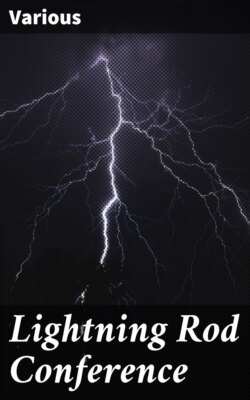Читать книгу Lightning Rod Conference - Various - Страница 7
На сайте Литреса книга снята с продажи.
Section I.—The purpose which a Lightning Conductor is intended to serve.
ОглавлениеTable of Contents
A flash of lightning is the passage of an electric spark between two bodies oppositely or unequally electrified, and between which the difference of electric pressure or potential is sufficiently strong to break across the air space which separates them, and to produce what is known as a disruptive discharge. A flash may pass either between one cloud and another, or between a cloud and the earth. In the former case damage is not likely to be done, in the latter damage is or is not done, according to the point at or from which the lightning strikes. The more any object projects above the general level, the less is the distance between it and the cloud, and as the less the distance the less the resistance offered to the discharge, high objects are, cœteris paribus, most frequently struck. Some substances, such as copper or iron, can conduct a large quantity of electricity with facility, and are called good conductors. Other substances, such as living vegetable or animal matter, offer much obstruction, and form only partial conductors; while dry earth, stone, and wood almost entirely prevent the passage of electricity, and are very bad conductors—in fact, insulators.
For instance, a man may with perfect impunity clasp a copper rod an inch in diameter, the bottom of which is well connected with moist earth, while the top of it receives a violent flash of lightning. But if the electricity does not find a path prepared for it, it will utilise such partial conductors as may be reasonably near, for example—the heated air from a kitchen chimney, the soot inside, and then the metal range at the bottom; here, however, stone or dry material is generally found, which will not conduct it, and then it dashes across the kitchen at some gas or water pipe, or some pump or drain leading to damp earth, doing serious damage on the way: or it may meet some tree in its course and rend it from top to bottom, and if the human body intervene life may be destroyed. Mechanical injury is inflicted only where the conduction for the discharge is imperfect.
A lightning conductor fulfils two functions: it facilitates the discharge of the electricity to the earth, so as to carry it off harmlessly, and it tends to prevent disruptive discharge by silently neutralising the conditions which determine such discharge in the neighbourhood of the conductor.
To effect the first object a lightning conductor should offer a line of discharge more nearly perfect, and more accessible, than any other offered by the materials or contents of the edifice we wish to protect. To effect the second object the conductor should be surmounted by a point or points. Fine points and flames have the property of slowly and silently dissipating the electrical charges; they, in fact, act as safety valves.
If all these conditions be fulfilled; if the points be high enough to be the most salient features of the building no matter from what direction the storm cloud may come, be of ample dimensions and in thoroughly perfect electrical connection with the earth, the edifice with all that it contains will be safe, and the conductor might even be surrounded by gunpowder in the heaviest storm without risk or danger.
All accidents may be said to be due to a neglect of these simple elementary principles. The most frequent sources of failure are conductors deficient either in number, height, or conductivity, bad joints, or bad earth connections. There is no authentic case on record where a properly-constructed conductor failed to do its duty.
